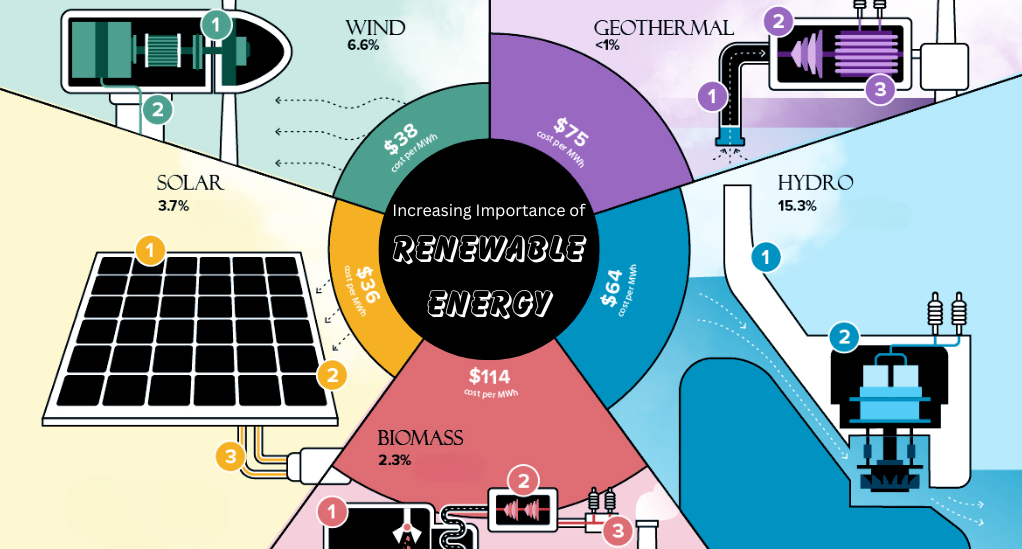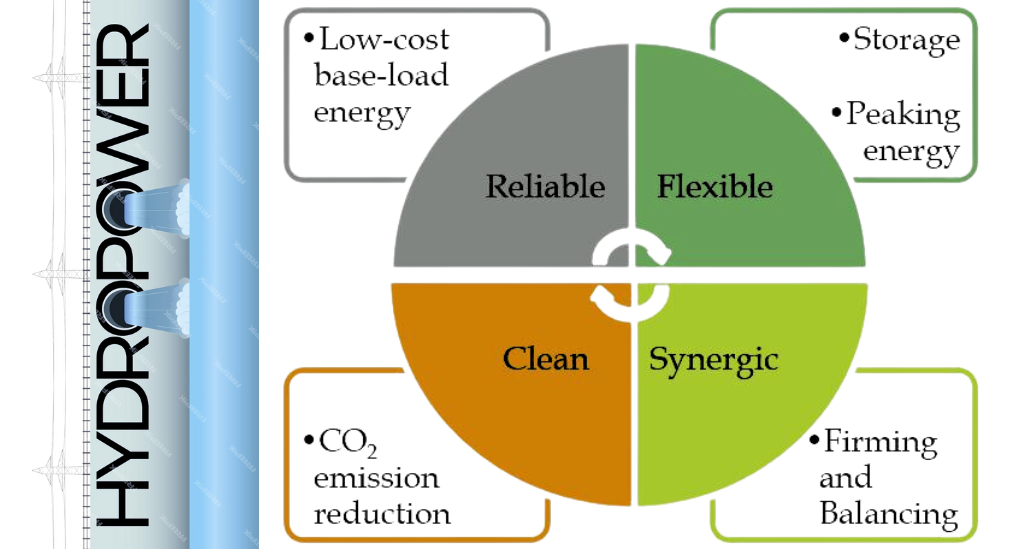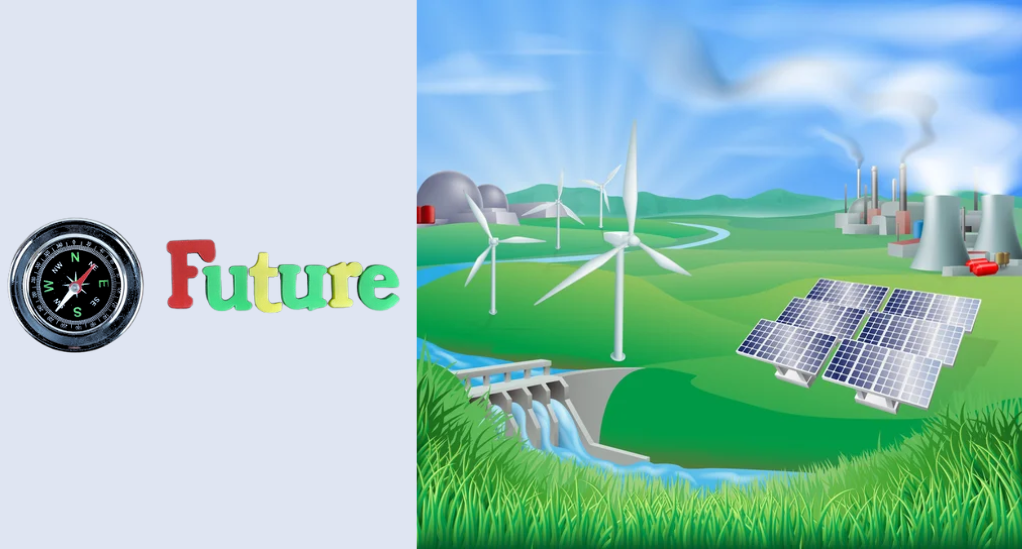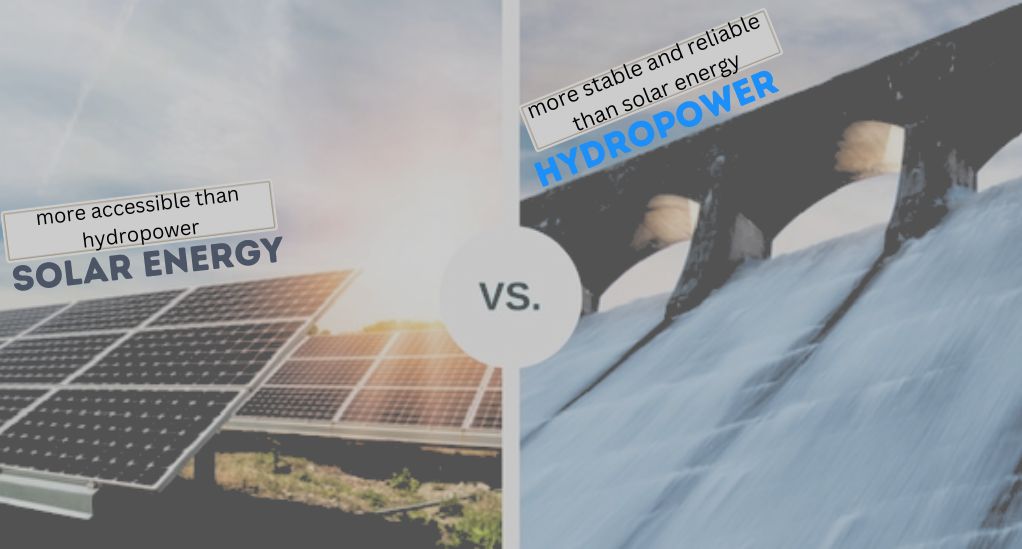In today’s rapidly evolving energy landscape, the quest for sustainable and eco-friendly power sources has never been more critical. As the world grapples with the adverse effects of climate change and the undeniable need to reduce carbon footprints, renewable energy emerges as the beacon of hope. This introduction delves into the escalating significance of renewable energy and spotlights two of its most prominent players: solar and hydropower.
Brief Overview of the Increasing Importance of Renewable Energy
The 21st century has witnessed an unprecedented surge in global temperatures, erratic weather patterns, and rising sea levels. These alarming changes, largely attributed to the excessive burning of fossil fuels, have sounded the clarion call for a shift towards more sustainable energy sources. Renewable energy, derived from natural processes that are continually replenished, offers a solution that not only addresses environmental concerns but also promises economic and social benefits.
Here’s a quick snapshot of why renewable energy’s importance is skyrocketing:

- Environmental Conservation: Unlike fossil fuels, renewable energy sources release minimal greenhouse gases, reducing the overall carbon footprint and mitigating global warming.
- Economic Growth: The renewable energy sector has created millions of jobs worldwide, from manufacturing solar panels to constructing wind turbines.
- Energy Independence: Relying on renewable sources reduces dependence on foreign oil, enhancing a nation’s energy security.
- Infinite Supply: Sunlight, wind, and water are inexhaustible sources, ensuring a long-term energy solution as opposed to depleting fossil fuels.
The Rise of Solar and Hydropower as Leading Renewable Energy Sources
Among the myriad of renewable energy options available, solar and hydropower have emerged as frontrunners. Their ascendancy can be attributed to their efficiency, scalability, and the technological advancements that have made them more accessible and cost-effective.
Solar Energy: Harnessing the power of the sun, solar energy has seen a dramatic drop in costs over the past decade, making it a viable option for both residential and commercial applications. Innovations in photovoltaic technology and the development of massive solar farms have propelled solar energy to the forefront of renewable energy solutions.
Hydropower: Tapping into the kinetic energy of flowing water, hydropower has been a trusted energy source for centuries. From ancient water wheels to modern mega-dams, hydropower’s ability to provide consistent and large-scale power generation makes it a staple in the renewable energy mix.
Understanding Solar Power
Solar energy, a cornerstone of renewable energy solutions, has been capturing human imagination for centuries. From ancient civilizations using the sun’s rays to modern technological marvels converting sunlight into electricity, solar power’s journey is a testament to human ingenuity and the relentless pursuit of sustainable energy. This section delves into the essence of solar energy, tracing its historical roots and explaining the mechanics behind its modern applications.
Definition and History of Solar Energy
Definition: Solar energy refers to the radiant energy emitted by the sun, which can be harnessed and converted into various forms, such as heat or electricity, using a range of ever-evolving technologies.
History: The utilization of solar energy can be traced back to ancient civilizations. The Greeks, Romans, and Chinese used magnifying glasses to concentrate the sun’s rays to light fires. Ancient Egyptian structures were designed with sun-oriented architecture, ensuring homes remained cool in the day and warm at night. Fast forward to the 7th century, when early greenhouses were developed to harness solar energy for growing plants.
The real turning point came in the 19th century with the discovery of the photovoltaic effect by French physicist Edmond Becquerel. This laid the groundwork for the development of solar cells. In 1954, Bell Labs developed the first silicon photovoltaic cell, marking the beginning of modern solar energy applications.
How Solar Power Works: Photovoltaic Cells, Solar Panels, and CSP Plants
Photovoltaic Cells (PV Cells): At the heart of solar power generation lies the photovoltaic cell. These cells, often made from silicon, convert sunlight directly into electricity. When sunlight hits a PV cell, it excites the electrons in the cell, creating an electric current. This phenomenon is known as the photovoltaic effect.
Solar Panels: A solar panel, or module, is an assembly of multiple PV cells connected in series or parallel, encapsulated to protect against environmental factors. These panels are mounted on structures and oriented to maximize exposure to sunlight. As sunlight hits the panels, the PV cells generate direct current (DC) electricity, which is then converted to alternating current (AC) using inverters, making it usable for homes and businesses.
Concentrating Solar Power Plants (CSP Plants): Unlike photovoltaic systems that directly convert sunlight into electricity, CSP plants generate electricity by using mirrors or lenses to concentrate a large area of sunlight onto a small area. This concentrated sunlight heats a fluid, producing steam that drives a turbine connected to a generator. There are various types of CSP plants, including parabolic troughs, solar power towers, and dish systems, each with its unique method of concentrating and converting sunlight.
Delving into Hydropower
Hydropower, often referred to as hydroelectric power, stands as one of the oldest and most established forms of renewable energy. Harnessing the immense power of water, civilizations throughout history have tapped into its potential, leading to the sophisticated hydroelectric systems we see today. This section delves deep into the essence of hydropower, tracing its historical evolution and shedding light on the intricate mechanics that underpin its modern applications.

Definition and History of Hydropower
Definition: Hydropower is the energy derived from the force or motion of moving water. It’s harnessed by converting the kinetic and potential energy of water into mechanical energy, which is then transformed into electricity.
History: The use of water for energy dates back thousands of years. Ancient civilizations utilized simple water wheels, driven by the flow of rivers and streams, to grind grain, saw wood, and perform other mechanical tasks. These early applications laid the foundation for more advanced water-driven technologies.
The Industrial Revolution in the 18th and 19th centuries marked a significant leap in hydropower applications. Water wheels evolved into more efficient turbines, leading to the first hydroelectric plants. In 1882, the world witnessed the birth of the first hydroelectric power station on the Fox River in Appleton, Wisconsin, USA. This pioneering endeavor paved the way for the large-scale hydroelectric dams and stations that dot our landscapes today.
The Mechanics of Hydropower: Dams, Turbines, and Hydroelectricity
Dams: A dam is a barrier constructed across a river or stream to impound water. By storing vast amounts of water and increasing its potential energy, dams create a height difference, or “head.” This head is crucial as the energy generated is proportional to the height of the water column. The stored water is then released in a controlled manner to drive turbines.
Turbines: As water is released from the dam’s reservoir, it flows through large pipes called penstocks, leading to turbines. The kinetic energy of the moving water turns the turbine blades, converting it into mechanical energy. Turbines come in various designs, with the most common being the Francis, Kaplan, and Pelton wheel turbines, each suited for different water flow conditions.
Hydroelectricity: Attached to the turbine is a generator. As the turbine spins, so does the generator’s rotor. This movement within a magnetic field induces a flow of electrons, generating electricity. The produced electricity is then stepped up in voltage using transformers, making it suitable for transmission and distribution to homes, businesses, and industries.
Key Differences Between Solar and Hydropower
While both solar and hydropower are pivotal in the realm of renewable energy, they harness energy from distinct natural sources and have unique characteristics. Their differences span across various facets, from location prerequisites to the intricacies of electricity generation and their respective environmental footprints. This section delves into these key differences, offering a comprehensive comparison between these two renewable energy giants.
Location Requirements for Both Energy Sources
Solar Energy:
- Geographical Flexibility: Solar installations can be set up in a variety of locations, from vast deserts to residential rooftops.
- Sunlight Dependency: Optimal locations are those with consistent and strong sunlight, such as equatorial regions or areas with minimal cloud cover.
- Land Considerations: Large-scale solar farms require significant land areas, preferably flat terrains, to maximize sunlight exposure.
Hydropower:
Water Source Dependency: Hydropower plants necessitate proximity to substantial water sources, like rivers or reservoirs.
Topographical Needs: The presence of elevation changes, like waterfalls or hilly terrains, can enhance energy generation due to increased water pressure.
Dam Construction: Large-scale hydroelectric plants often require damming, which means locations must be suitable for dam construction and reservoir creation.
Methods of Electricity Generation
Solar Energy:
Photovoltaic (PV) Systems: Directly convert sunlight into electricity using semiconductor materials. When sunlight hits these materials, electrons are dislodged, creating an electric current.
Concentrated Solar Power (CSP): Utilize mirrors or lenses to focus sunlight onto a small area, typically a tower. This concentrated heat is then used to produce steam, which drives turbines connected to generators.
Hydropower:
- Turbine-Driven: The kinetic energy of flowing or falling water spins turbines. The movement of these turbines, in turn, drives generators to produce electricity.
- Pumped Storage: Functions as both a generator and a battery. During periods of low electricity demand, excess electricity is used to pump water into elevated reservoirs. During peak demand, this water is released to generate electricity.
Environmental Impacts Before and During Construction
Solar Energy:
- Land Use: Large solar farms can disrupt local ecosystems due to land clearing. However, solar panels on rooftops or brownfield sites have minimal environmental impact.
- Resource Extraction: The production of solar panels involves mining for materials like silicon, which can have environmental consequences.
- Waste Management: End-of-life disposal or recycling of solar panels remains a challenge, though advancements are being made in sustainable recycling methods.
Hydropower:
Aquatic Ecosystem Disruption: Damming rivers can alter water temperatures, sediment transport, and aquatic habitats, impacting fish and other species.
Land Submersion: Reservoir creation can submerge vast areas, affecting terrestrial ecosystems and sometimes leading to the displacement of local communities.
Methane Emissions: Decomposition of organic matter in reservoirs can release methane, a potent greenhouse gas.
Environmental Impact: A Closer Look
The transition to renewable energy sources like solar and hydropower is driven by the urgent need to mitigate the environmental repercussions of fossil fuels. However, while these renewable sources offer a more sustainable energy alternative, they are not without their environmental challenges. This section delves deeper into the environmental impacts associated with solar and hydropower, shedding light on the complexities of achieving truly sustainable energy solutions.
The Environmental Challenges of Solar Power: Mining Operations and Material Extraction
Solar Energy has been lauded for its minimal carbon emissions during operation. However, the production phase of solar panels presents environmental challenges:
- Mining Operations: The extraction of raw materials, especially metals like silver, aluminum, and silicon, required for photovoltaic cells involves mining. These mining activities can lead to habitat destruction, soil erosion, and water pollution.
- Water Use: The manufacturing process of solar panels, especially the purification of silicon, demands significant amounts of water, which can strain local water resources in arid regions.
- Chemical Pollution: The production of solar cells involves chemicals like hydrofluoric acid, which, if not managed properly, can contaminate local water sources.
- Waste Management: As solar panels reach the end of their life cycle, there’s a growing need for effective recycling methods to manage the waste and recover valuable materials.
The Environmental Challenges of Hydropower: Ecosystem Disruption, River Course Changes, and Displacement
Hydropower, while a significant source of renewable energy, has profound environmental and social implications:
- Ecosystem Disruption: Dams can obstruct fish migration routes, impacting species that rely on upstream movement for spawning. This can lead to a decline in fish populations and affect those who rely on fishing for their livelihood.
- River Course Changes: Altering a river’s natural course can lead to sediment buildup in reservoirs, reducing water quality and affecting aquatic life. Downstream, reduced sediment flow can lead to coastal erosion and loss of habitats.
- Displacement: Large hydroelectric projects often require the creation of vast reservoirs, which can submerge forests, agricultural lands, and even entire communities. This leads to the displacement of local populations, often without adequate compensation or rehabilitation.
- Greenhouse Gas Emissions: Contrary to popular belief, dams, especially in tropical regions, can emit greenhouse gases. As vegetation in submerged areas decays, it releases methane, a greenhouse gas far more potent than carbon dioxide.
The Future of Renewable Energy

The global energy landscape is undergoing a transformative shift, with renewable energy sources poised to play a central role in the future energy matrix. As the urgency to combat climate change intensifies and technological advancements continue to break new ground, the narrative around renewable energy evolves. This section delves into the future trajectory of renewable energy, emphasizing the importance of a diversified approach and the pivotal roles of solar and hydropower.
The Need for a Diversified Approach to Renewable Energy
Diversification as a Strategy: Just as financial portfolios benefit from diversification to mitigate risks, the energy sector needs a mix of renewable sources to ensure reliability and resilience. Solely relying on one energy source can expose the grid to vulnerabilities, be it due to weather patterns, technological challenges, or resource limitations.
Complementary Nature of Sources: Different renewable energy sources have varying production profiles. For instance, while solar power peaks during sunny days, wind energy might be more consistent during the night or specific seasons. Hydropower can act as a base-load source, providing consistent energy. By integrating multiple sources, energy production can be optimized throughout the day and year.
Technological Synergy: Advancements in one renewable technology can benefit others. For example, improvements in energy storage solutions, initially designed for solar or wind, can also enhance the flexibility and efficiency of hydropower.
Geographical Considerations: Different regions have distinct renewable energy potentials. While some areas might be abundant in sunlight, others might have strong river systems conducive for hydropower. A diversified approach allows regions to harness their unique renewable strengths while importing or supplementing with other sources.
The Role of Solar and Hydropower in a Sustainable Future
Solar’s Bright Future: With the cost of solar technology plummeting and efficiency rates soaring, solar energy is set to become even more accessible and widespread. Innovations in solar storage solutions, coupled with decentralized solar systems, can revolutionize energy access, especially in remote or off-grid areas.
Hydropower’s Consistent Contribution: As one of the oldest renewable sources, hydropower’s role remains significant. Modern innovations, such as small-scale hydro projects and eco-friendly turbine designs, aim to harness hydropower’s potential while minimizing environmental impacts. Furthermore, pumped storage facilities can complement intermittent renewable sources, acting as energy reservoirs.
Collaborative Potential: Solar and hydropower can work in tandem. For instance, floating solar panels on hydro reservoirs are an emerging trend, maximizing the energy potential of a single location. Such hybrid systems exemplify the collaborative future of renewable energy.
Conclusion
The future of renewable energy hinges on the harmonious integration of diverse sources, with solar and hydropower playing pivotal roles. Embracing a diversified approach ensures a resilient and efficient energy grid, optimizing the unique strengths of each source. As technological innovations bridge the gaps between these energy forms, we’re ushered into an era where sustainability and efficiency coalesce, promising a brighter, cleaner future for all.

